14
George Douglas Blacksmith, Tatamagouche, Nova Scotia, Canada1900
Tatamagouche, Nova Scotia, Canada
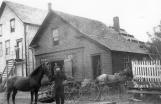 Credits:
Credits:North Shore Archives. CSHC
15
Earltown & Area BlacksmithsThere were a number of small communities round Earltown, including Clydesdale, Rossville, McBains Corner, where the blacksmith was in most cases working from a forge on his farm, mending tools, and equipment.
Between 1830 and 1920, the Earltown area was served by some 15 blacksmiths; all seemed to provide farrier services (as farmers depended on horse teams), farm equipment services, hand tools, and support for the carriage trade.
Finley G. Ross- took over a blacksmith premises at the junction of Denmark and Back Mountain road (at McBain's corner), from Robert Sutherland, sometime previous to 1901. Ross later moved to the junction of Balmoral and Waugh's River Rd., where he worked until retirement.
Robert Sutherland- set up a forge in 1880-90, for farms, households, and his brothers' carriage shop. He had three shops, one in Earltown, East Earltown, and Balmoral. By 1900, he saw the need for precision work in mechanic shops. In 1902, he joined with his brother at Balmoral and established his third shop on Matheson Brook. They bought a steam engine to power the lathes, planers, shaper, and power drill. He could supply replacement parts as well as refuelling the blacksmith trade. World War 1 saw him working on an improved rifle "sight" but the production of a more efficient rifle made his work obsolete. Sutherland died in 1918 and his sons continued his work until the 1920's.
George Henderson- one of the early blacksmiths in Earltown. Born in Scotland where he learned his trade as an apprentice, he immigrated to Nova Scotia and spent time in River John, later moving to Earltown .. According to the census of 1871 he had a wife and nine children, and a shop established 2 miles west of Earltown's post office, on Waugh's River, on their farmland. His son William continued on as a blacksmith and another son John, was a joiner. By 1881, the farm was listed under Robert Henderson, another member of the family; George and some of the family moved to Manitoba, so the blacksmith shop probably closed 1871-1881.
George Sutherland- had a blacksmith shop established by 1864 near the schoolhouse and tannery. Possibly a leased property. Philip Lone might have bought the business in 1880.
Angus Payne- of Biorachan had a blacksmith shop east of the post office, and served the local farms. He was apprenticed to George Henderson and married his daughter. He was operating the farm and blacksmith shop in 1871, doing general repairs and carriage work. When he retired, Duncan Taylor- who possibly worked for Angus, took over the shop for a short time after 1900.
Other blacksmiths included:
Robert Munro- 1880? Operated in East Earltown, a small farm shop, carpentry, blacksmith.
Murdoch MacKay- 1870s- blacksmith came second to farming,on River Road one mile from the village. General repairs and maintenance of farm and household goods.
Daniel MacDonald- blacksmith 1890-1891
William McKay in 1892 -5, and his son, Kenneth McKay- the Falls area.-blacksmith-1892 /93 and possibly longer
Neil Murray - moved his shop from McBain's corner
David MacLeod- of Denmark, lost his business in a fire and joined John MacLeod in his woodworking business
John McBeath- was the first blacksmith in Clydesdale on Biorachan Rd. He was in Earltown by 1902, where the the United Church is now sited. He built his second shop on the west side of Denmark road. He was an operating blacksmith for many years, helped by his son, John.
Rex Mingo- on McBain's corner. Was a full farrier, whose livelihood went with the arrival of motor vehicles and tractors.
John MacKay-. He had a blacksmith shop by the hotel in Earltown on the Truro Road. He worked it until he moved west in 1881. The son continued to farm, and the shop was turned into a storage shed.
Alex Baillie- Biorachan Road. His family had a blacksmith shop until 1900.
16
C.A. Mingo Blacksmith, North Shore, Nova Scotia, Canada19th Century
North Shore, Nova Scotia, Canada
 Credits:
Credits:North Shore Archives CSHC
17
Wallace BlacksmithsSampson Chapman- at the southeast corner of Aboiteau and Fanningborough roads. There may have been another "smithy" there before the mid 1800s
Reuben Layton was located on southeast side of Highway 6 and Fountain Road at approximately the same time. He sold his premises to Andrew Peers who ran it until his death in 1916. Harvey Mitchell then ran the store until his death in 1969; the shop was then torn down.
Parmenos Peers- 1841-1907
Thomas Tuttle- 1833-1927
The Church Map of 1869 shows two blacksmiths amongst the shipyards to the east of the village and lists on the directory
J. McLennan,
D.Betts,
J.C.Chapman.
H.Hurd,
Malagash had a blacksmith shop near the cenotaph possibly run by Jas.Johnson , 1872 - 1926?
River John blacksmiths - many worked for the shipyards, carriage trade and currier business
David Perrin- 1882-1902
Eben McLeod- 1882-1898
Jas. L. McLeod- 1892
Smith McLeod- 1902-1931
George McLeod- 1902-?
Jon McPhee- 1915-?
Clarence Mingo- 1906 (and carriage shop)
Walter Perrin- 1908-?
Shurman Sillers- 1902-1929
V. Brown- 1906-1907
Collie Dwyer- 1906-1912
Clarence Langille- 1906-1907
Mac Cailie- 1920-?
George MacKay- known 1879
David Langil- known 1879
James W. O. Gullon- known 1879
Daniel Mackenzie- known 1879
According to the 1881 census, there were 41 blacksmiths.
18
Stagecoach: River John, Nova Scotia, Canadalate 1800's
River John, Nova Scotia, Canada
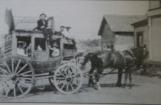 Credits:
Credits:North Shore Archives CSHC
19
The Stage CoachRiver John
Hiram Hyde of Truro ran the Stage Coach Lines from Halifax to Truro to Pictou in 1840. In 1860 his six- horse drawn Concord Coach carried Prince Edward on a royal visit to Canada. This coach was later bought by William Gammon and used as a stage coach from Pictou to River John, going by the old post road and then to Truro. The Riverside Hotel was the coach stop in River John and mailbags and parcels, plus passenges, were loaded there Burke's barn nearby was where the horses were stabled, and goods brought in and stored.
There is an exciting account of when the stage was driven through a forest fire - flames were so close that whiskers were scorched from faces; the terrified horses and screaming female passegers must have made this a nightmare journey, but all survived.
The coach was later taken to Banff, Alberta, where it was used to transport hotel guests to the station.
20
The Stage, Tatamagouche, Nova Scotia CanadaEarly 1900
Tatamagouche, Nova Scotia, Canada
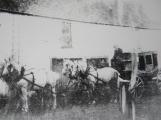 Credits:
Credits:Ellen Millard
21
TatamagoucheSaid to be William Gammon on the coach and possibly the last run before the service ceased
A stage coach once ran from Truro to the Stirling Hotel in Tatamagouche. It followed the Old Truro Road (the Silica Road), through the Cobequid Mountains to the village. The second route went as far as Wallace, possibly beyond. There were six horses per coach and the service had two stagecoaches, driven by James Blair and his two sons.
Israel Longfellow, writing in his 'History of Colchester', mentions several stage coach drivers with mail contracts. Mr. Blair was listed as having the Tatamagouche/Wallace to Truro line. He began in the mid 1800s, when he purchased land, cleared for a farm, and either built or added on to an existing house for his large family. He had a servant who was a groom for the horses. Blair, in fact, later owned the Stirling Hotel, renaming it the Tatamagouche Inn. He built two large barns with an exercise yard for the horses. He kept 25 horses to ensure that there were always fresh horses to "take the stage".
22
Stagecoach Stop, Colchester County/Cumberland County Border, Nova Scotia, Canada29 July 2010
New Annan, Nova Scotia, Canada
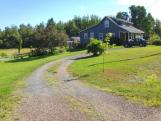 Credits:
Credits:R. Campbell
23
Known as a stage coach rest stop for passengers and watering site for the horses - Fred Munro's place must have offered a welcome break for the passengers thrown around when travelling the poor roads.A stagecoach could carry as many as eight people and their luggage in good weather, and would leave Tatamagouche every day. In winter, drifted snow on roads meant digging a track through for the hoses. In spring and fall, the changing seasons made for soupy, muddy roads; men were expected to get out and push.
One of these coaches may have ended up in Calgary for the stampede.
The Stagecoach era ended with the coming of the railways.
24
Hotels: Stirling Hotel, Tatamagouche, Nova Scotia, CanadaEarly 1900's
Tatamagouche, Nova Scotia, Canada
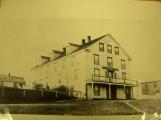 Credits:
Credits:North Shore Archives, CSHC
25
Hotels:Stirling Hotel, Tatamagouche
The hotel possibly went through some tough times in its younger years as a series of owners passed in rapid succession. These included Charles D. McCurdy, Mr. Copp (1848), Mrs. Talbot, and then James Blair until 1860. Four more owners attempted the hotel market until it was bought by Timothy McLellan and his son who ran it for many years.
The hotel register from 1900-1908 showed that many characters came to stay in Tatamagouche, including concert teams, jubilee singers, and hoards of dog show participants. Some rooms were rented for $1 a day.
The hotel was then taken over by Clarence Lockerbie and his wife, Myrtle. There was a stable for guest's horses and a pillared veranda -all very imposing!
Business declined until eventually it was torn down.
There was another hotel, run by Mrs. Kent, after her husband died. This was the Temperance Hotel, shown on the A.F. Church map of 1864,(74) but the actual position is unclear, it being either on the main street or an adjacent road.
26
Riverside Hotel, River John, Nova Scotia, Canada1900's
River John, Nova Scotia, Canada
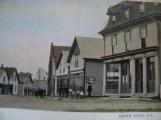 Credits:
Credits:Roy Kennedy Collection
27
River JohnThe Riverside Hotel is partly there still.
Overlooking the river on Main Street, the building started in 1885 - it was a three-storey structure with an elaborate third floor. There was a large ballroom, and beautifully finished dining room. Charles McLennan owned the hotel until 1921 after which it changed hands several times. Charlie Gammon bought it in 1929 and ran it until 1953 ; after this it eventually became a hardware store and general store. 1993,and only the first and second floors remained. Today the first two floors are incorporated into a general store.
On the east side of the river was another inn- the building is still there as a private residence.
Earltown
The church map of 1864 shows a hotel close by the brook. to the south of the main settlement. It was first run by Charles Graham, but by 1911, it was run by Benjamin McNutt. It seems that Ben McNutt and Watson McNutt were also mail drivers for the area. There is no evidence left of the hotel.
Close by it were a tannery, school house and blacksmiths.